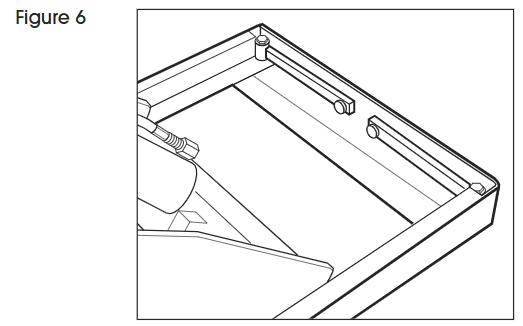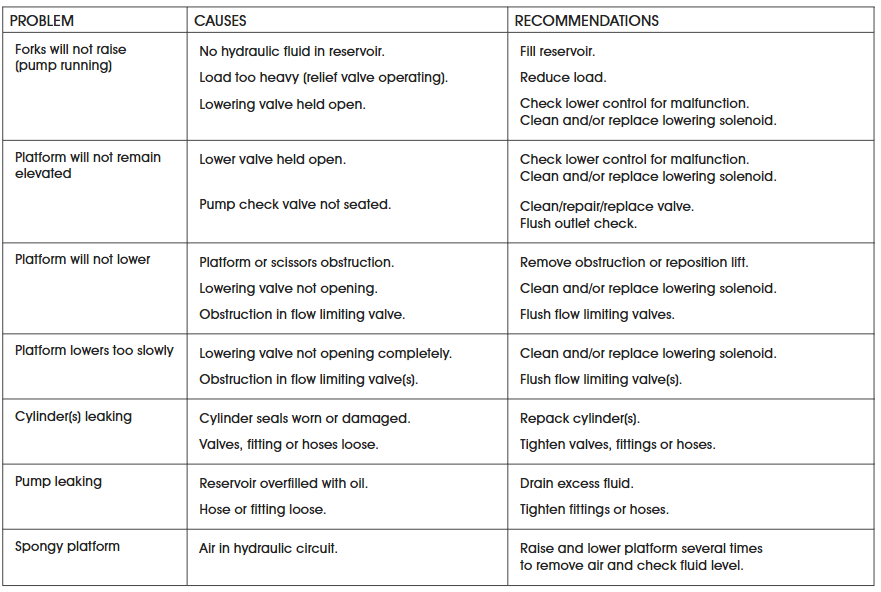ULINE H-3934, H-3935 Electric Lift Table
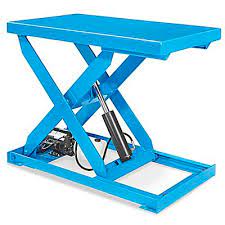
TECHNICAL INFORMATION
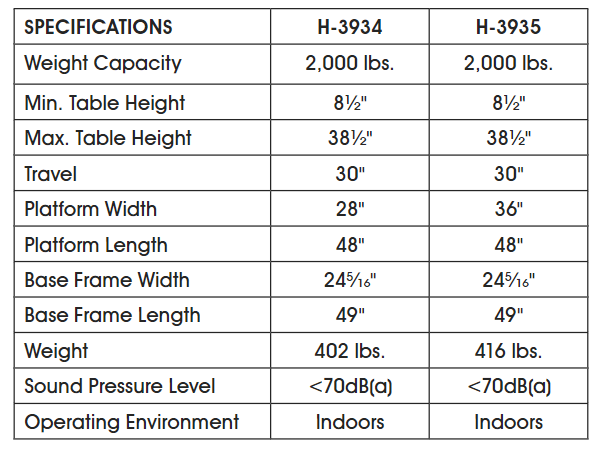
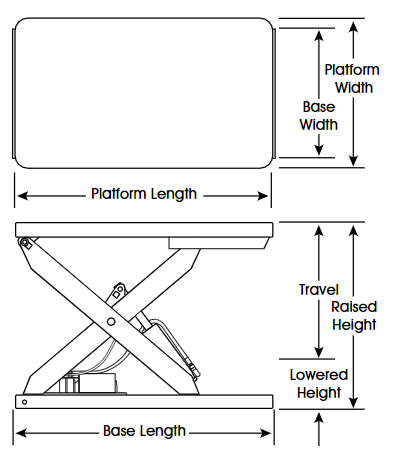
SAFETY GUIDELINES
WARNING! Do not operate this lift table unless you have been trained to use it, authorized to do so and have checked that it is in good condition. The operator should read all of the warning signs and instructions here and on the lift table before using it.
- DO NOT concentrate the load at one point on the platform or pallet. ALWAYS uniformly distribute each layer of load over the supporting surface.
- DO NOT use the lift for any purpose other than its intended use.
- DO NOT install the lift table on an unlevel or soft surface. The lift base frame must be supported along its entire length and width. Failure to completely support the base frame could result in damage to the lift.
- DO NOT use the lift table with an unstable, unbalanced or loosely stacked load. Unbalanced loads may become unstable and fall. SEVERE PERSONAL INJURY and PROPERTY DAMAGE may result.
-
DO NOT overload the lift table. ALWAYS stay within the designated capacity ratings. SEVERE PERSONAL INJURY and PROPERTY DAMAGE could result.
-
SHEARING HAZARD. ALWAYS keep hands and feet clear of the scissor mechanism and all moving components. DO NOT put hands or fingers under the platform when in use. SEVERE PERSONAL INJURY could result.
-
CRUSHING HAZARD. ALWAYS keep hands and feet clear of all moving components. DO NOT put feet on the base frame when in use. SEVERE PERSONAL INJURY could result.
-
PINCH POINT HAZARD. ALWAYS keep feet, hands and fingers away from the underside of the platform and all moving components. SEVERE PERSONAL INJURY could result.
-
DO NOT change the relief valve setting. The relief valve is installed to protect the operator and the lift table. Changing the relief valve setting may compromise the performance and safety of the lift. SEVERE PERSONAL INJURY and PROPERTY DAMAGE could result.
- NEVER leave the loaded lift table unattended unless the platform is in the fully lowered position.
- ALL lift servicing must be performed by qualified personnel only. Unauthorized modifications to this lift table, its hydraulic power unit or its control system may compromise the performance and safety of the system. UNDER NO CIRCUMSTANCES should you attempt any repair or service that is not covered in this manual.
- The release of fluids under high pressure can cause SEVERE PERSONAL INJURY. Before servicing the lift, ALWAYS remove all of the load, engage the maintenance bars and RELEASE THE HYDRAULIC PRESSURE.
- ALWAYS ensure all safety warning labels are in place and legible. If not, remove the lift table from service and replace the required labels.
- ALWAYS securely anchor the base frame to the floor to ensure maximum stability.CAUTION! DO NOT continue to operate the pump if a squealing noise is heard coming from the pump. The pressure relief valve is operating. Continued use of the pump with the relief valve operating may cause permanent damage to the pump. REDUCE the load to prevent the relief valve from operating.
RECOMMENDED FLOOR AREA
The lift table’s recommended floor area is a distance of 39 inches (1 meter) from the unit on all sides.DANGER! A falling lift table can cause SEVERE PERSONAL INJURY or DEATH. NEVER go under the platform until the load is removed and the scissors mechanism is secured in the raised position with the maintenance bars. The maintenance bars have been designed for use only when the lift is UNLOADED. NEVER place any load on the platform with the maintenance bars engaged. SEVERE PERSONAL INJURY or DEATH and PROPERTY DAMAGE could result.
INSTALLATION INSTRUCTIONS
The lift table is shipped on a pallet and only requires minor assembly before it is ready for use. Before you begin, locate and identify the components (See Figure 1). These components will be referred to in the installation procedures. Make sure you understand the function of each component before proceeding. 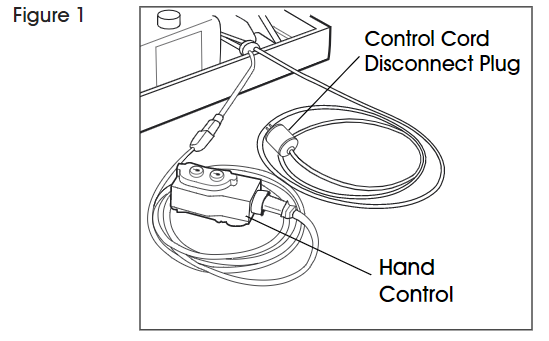
Power Cord – All lift tables are supplied with an 8 ft. power cord of the proper size and rating for the hydraulic power unit.Power Cord Plug – All lifts are supplied with a power cord plug for use with a conventional 115 volt (20 amp) receptacle.Hand Control with Control Cord Disconnect Plug – All lift tables are supplied with a hand control (See Figure 1) that is used to raise or lower the lift. The control cord is 10 feet long and is supplied with a molded control cord disconnect plug on the end.Control Cord Disconnect Receptacle – All lift tables are supplied with a control cord disconnect. The female receptacle is located at the power unit end of the base frame.Reservoir Breather – All lift tables are supplied with hydraulic fluid in the reservoir. The breather is conveniently located on top of the reservoir near the end of the lift table and must be removed to check the fluid level or to add hydraulic fluid.Base Frame Anchor Holes – 4 pre-drilled base frame anchor holes are provided inside the base frame to secure the lift to the floor or installation surface.
Tools Required
- Banding or Strap Cutters
- Drill with 1/2″ concrete drill
- 3/4″ closed end wrench
DANGER! The lift’s electrical circuits use voltages which can cause SEVERE PERSONAL INJURY or DEATH.
- Using a forklift or similar equipment, move the palletized lift to the location it is to be installed. The installation area should be clean and have good general lighting.
- Next, using the strap cutter, remove the bands securing the lift to the pallet. Remove all packing material and place it off to the side.
- Locate a separate box that contains the hand control. This box is located under the primary packaging material at the end of the base frame. Remove the hand control with the control cord from the box. Next, insert the control cord disconnect plug into the mating receptacle at the end of the base frame. Ensure the plug is fully connected and the locking tabs are positioned over the posts on the disconnect receptacle
- Locate the power cord attached to the lift’s base frame. All lifts are supplied with a power cord plug for use with a conventional 115 volt (20 amp) receptacle. Ensure the receptacle to be used is rated for 115 volt, 20 amp operation. Insert the plug into the receptacle.
- Using the hand control, depress the UP button to raise the lift to its maximum raised height. Following the maintenance bar operating instructions, (See Page 5) rotate the maintenance bars into the maintenance position.CAUTION! DO NOT lower the lift to engage the maintenance bars at this time.
- Using a forklift, position the forks under the platform structure. (See Figure 2) Lift the lift table off the pallet. Next, remove the pallet and place if off to the side. Position the lift in the desired location. Use care not to damage the lift’s power cord or control cord.
 NOTE: The base frame must be secured to the floor for maximum stability. Contact ULINE Customer Service if you have any questions regarding the proper installation of the lift. Complete steps 7 and 8 to secure lift to the floor.
NOTE: The base frame must be secured to the floor for maximum stability. Contact ULINE Customer Service if you have any questions regarding the proper installation of the lift. Complete steps 7 and 8 to secure lift to the floor. - Inside the base frame are four 5/8″ holes for bolting the unit securely to the floor. Using the 4 holes as a template, drill a 1/2″ diameter hole to a 3″ minimum depth at each location. The floor surface should be level and the drilled holes perpendicular to the floor. If required, shift the position of the lift with a forklift to allow room for drilling, then drill. When complete, reposition the lift.
- Prepare the 1/2″ diameter x 4″ long anchor bolts (USE type SUP-R-STUD #26-12400 or equivalent) by assembling the washer and nut on the anchor bolt. (See Figure 3) The nut should be screwed onto the anchor bolt approximately 1/2 the nut height. Drive the assembled anchor through the mounting hole into the concrete until the washer is flush with the top of the anchor plate. Expand the anchor shield by tightening the nut 3 to 5 turns. Repeat step 8 for the remaining anchors.
 NOTE: Make sure the underside of the base frame surface is fully supported with shims or concrete grout.
NOTE: Make sure the underside of the base frame surface is fully supported with shims or concrete grout. - Rotate the maintenance bars to their stored position and run the lift up and down several times to remove any air that may have been trapped in the hydraulic system due to shipping.
- The lift is now ready for operation. Refer to the following section for complete operating instructions.
OPERATING INSTRUCTIONS
RAISING THE LIFT PLATFORM
- Before raising the platform, BE SURE that all others are well clear of the lift. If the platform is loaded, RECHECK the position and condition of the load.
- Depress the UP button to raise the platform to a convenient position. (See Figure 4).
 CAUTION! CONTINUOUSLY WATCH the condition of the load as the platform is raised. If the load appears to be shifting, STOP, lower the platform and adjust the load.
CAUTION! CONTINUOUSLY WATCH the condition of the load as the platform is raised. If the load appears to be shifting, STOP, lower the platform and adjust the load.
LOADING/UNLOADING THE PLATFORM
- Check the load or component weight to ensure the total load does not exceed the capacity of the lift. Refer to the capacity decal on the end of the lift platform.
- If required, raise the platform to a convenient working height.
- Uniformly distribute the load over the platform or supporting surface and ensure the load is tightly stacked.WARNING! DO NOT concentrate the load at one point on the pallet or platform. ALWAYS uniformly distribute each layer of load over the supporting surface. DO NOT use the lift table with an unstable, unbalanced or loosely stacked load. Unbalanced loads may become unstable and fall. SEVERE PERSONAL INJURY and PROPERTY DAMAGE could result.WARNING! DO NOT overload the lift table. ALWAYS stay within the designated capacity ratings. SEVERE PERSONAL INJURY and PROPERTY DAMAGE could result.
LOWERING THE LIFT PLATFORM
- Before lowering the platform, BE SURE that you, as well as all others, are well clear of the lift. If the platform is loaded, RECHECK the position and condition of the load.
- Depress the DOWN button to lower the lift platform. (See Figure 4)CAUTION! CONTINUOUSLY WATCH the condition of the load as the platform is lowering. If the load appears to be shifting, STOP and adjust the load.
MAINTENANCE
The lift table is designed to provide years of trouble-free service and requires very little maintenance. However, a routine inspection and maintenance program will prevent costly replacement of parts and/or downtime. All service should be performed by a qualified service person who has an understanding of lift equipment and hydraulic diagrams. This person should be thoroughly familiar with the operation and use of this type of equipment.DANGER: A falling lift table can cause SEVERE PERSONAL INJURY or DEATH. NEVER go under the platform until the load is removed and the scissors mechanism is secured in the raised position with the maintenance bars.
ENGAGE THE MAINTENANCE BARS
- Remove all load from the platform and raise the lift table to its fully raised position.NOTE: The maintenance bars have been designed for use only when the lift is UNLOADED. NEVER place any load on the platform with the maintenance bars engaged. SEVERE PERSONAL INJURY or DEATH and PROPERTY DAMAGE could result.
- Move to the roller end of the lift. (See Figure 5) Rotate each maintenance bar approximately 90° until the bar contacts the roller channel. Ensure both bars are positioned correctly.

- Lower the lift by depressing the DOWN button. The lift will lower slightly until the scissors rollers contact the maintenance bars.
- Release the DOWN button. ALWAYS check the position of both maintenance bars before going under the platform or servicing the lift
DISENGAGE THE MAINTENANCE BARS
- Depress the UP button to raise the platform to its fully raised position. When the lift is fully raised, release the UP button.
- Move to the roller end of the lift and rotate each maintenance bar approximately 90° to its stored position. Ensure both bars are in the stored position. (See Figure 6)

DAILY INSPECTION
- If the lift is equipped with an accordion bellows skirt, lift the bottom of the bellows skirt and secure it in the raised maintenance position with the maintenance ties.
- ALWAYS engage the maintenance bars and ensure the scissors mechanism is securely blocked in the raised position before performing ANY lift inspection or maintenance.
- Before use, visually inspect the lift for worn, damaged or broken components. If any of these conditions exist, REMOVE the lift from service and contact a qualified person.
- Raise the platform and visually inspect the hydraulic components (i.e., pump, hoses, fitting and cylinders) for oil leakage. If oil leakage exists, REMOVE the lift from service and contact a qualified service person.
- Check the condition of the warning labels. They are for the safety of the operator. If the labels are worn, missing or unreadable, REPLACE them before placing the lift back in service. Finally, raise the lift and disengage the maintenance bars by returning them to their stored position.
MONTHLY INSPECTION AND MAINTENANCE
- If the lift is equipped with an accordion bellows skirt, lift the bottom of the bellows skirt and secure in the raised maintenance position with the maintenance ties.
- ALWAYS engage the maintenance bars and ensure the scissors mechanism is securely blocked in the raised position before performing ANY lift inspection or maintenance.
- Inspect snap rings and roll pins at all pivot shaft and axle locations. If not in place and/or secure, replace or repair at once.
- Inspect the scissors rollers, cylinder pivot pins, cylinder bushings, scissors pivot pins and scissors bushings for signs of wear. If worn, replace at once. All pivot locations have lifetime lubricated bushings; therefore, they do not need grease or lubrication.
- Inspect the hydraulic power unit and cylinder for signs of leakage. The presence of a small amount of fluid around the cylinder rod is normal. However, fluid flowing from around the top of the cylinder head cap indicates worn seals. Replace the cylinder seals at once.
- Inspect the hydraulic lines for chaffing and sign of wear. If worn, replace at once.
- Inspect the hydraulic line connections for tightness. Tighten if necessary.
- To check the level and appearance of the hydraulic fluid (See Figure 7) raise the unloaded platform and engage the maintenance bars. All lifts are equipped with translucent plastic reservoirs making it possible to visually determine the fluid level without opening the reservoir cap. The proper fluid level is checked only when the lift is on the maintenance bars. Check the fluid level using the fluid level arrow decal. If required, add oil to the reservoir. Next, remove the reservoir breather and check the condition of the oil; it should appear light in color. The oil should be changed if the color has darkened or if the oil feels gritty. Obtain an oil sample to feel between your fingers by dipping a shaft-shaped object into the top of the reservoir opening. Reinstall the reservoir breather.

- Finally, raise the lift and disengage the maintenance bars by returning them to their stored position.
CHANGING THE AW32 HYDRAULIC OIL (EVERY 12 MONTHS)
- Change the hydraulic oil every 12 months of service or more often if conditions warrant. The frequency of fluid change will depend upon the general working conditions, severity of use and the overall cleanliness and care given to the lift. To do so, raise the unloaded platform to its maximum height and engage the maintenance bars. Lower the lift onto the maintenance bars. Depress and hold the DOWN button for several seconds to allow any residual hydraulic pressure to diminish.
- Remove the snap ring that secures the upper cylinder pin and then remove the upper cylinder pin.
- The hydraulic fluid inside the cylinder needs to be purged from the system. Disconnect the hydraulic line from the power unit and place the hose end into a suitable container that will hold the spent hydraulic fluid. The cylinder rod can now be pressed back into the cylinder pushing the fluid out of the cylinder into the container. Press the rod firmly and slowly until it has completely bottomed and reattach the hydraulic line to the power unit.
- The fluid remaining in the power unit reservoir needs to be purged from the system as well. Disconnect the hydraulic line from the cylinder and place it in the container. Press the UP button and run the power unit until the fluid is purged from the reservoir. Next, add a small amount of new hydraulic fluid to the reservoir and run the pump. Repeat this process until the old hydraulic fluid is completely purged from the system. Reattach the hydraulic line to the cylinder.
- The old hydraulic fluid is considered hazardous waste and should be handled and disposed of properly. Clean all spilled oil and thoroughly inspect the lift and all hydraulic components.
- Lift is supplied with a quality hydraulic oil with rust and oxidation inhibitors and anti-wear properties for use in normal ambient temperatures.
- Fill the reservoir with the new hydraulic fluid and run the motor by pressing the UP button to prime the pump and extend the hydraulic cylinder. Jog the UP button to slowly extend the cylinder until the hole in the cylinder rod lines up with the holes in the cylinder mounting clevis. Replace the upper cylinder pin and corresponding snap ring.
- Raise the lift to its maximum height and disengage the maintenance bars. Completely raise and lower the lift 3 times to remove any trapped air from the hydraulic system.
- Completely raise the lift and engage the maintenance bars. Recheck the fluid level as detailed in the “Monthly Inspection and Maintenance” section. (See Page 6) The lift is now ready for use.
TROUBLESHOOTING

[xyz-ips snippet=”download-snippet”]



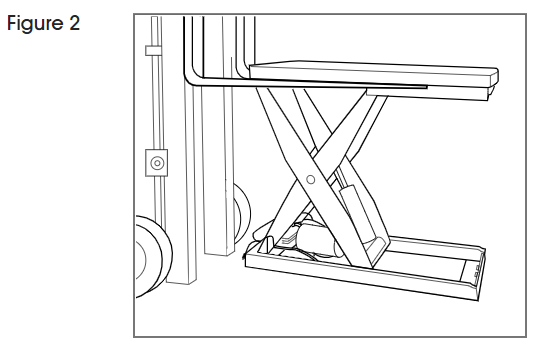 NOTE: The base frame must be secured to the floor for maximum stability. Contact ULINE Customer Service if you have any questions regarding the proper installation of the lift. Complete steps 7 and 8 to secure lift to the floor.
NOTE: The base frame must be secured to the floor for maximum stability. Contact ULINE Customer Service if you have any questions regarding the proper installation of the lift. Complete steps 7 and 8 to secure lift to the floor.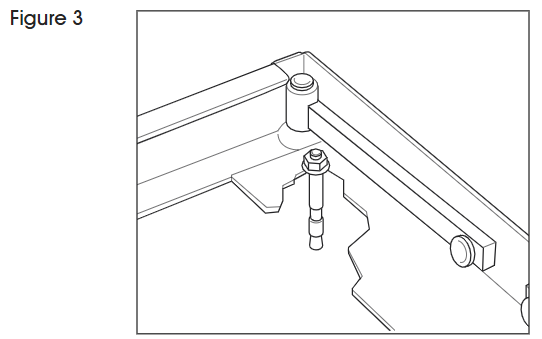 NOTE: Make sure the underside of the base frame surface is fully supported with shims or concrete grout.
NOTE: Make sure the underside of the base frame surface is fully supported with shims or concrete grout. CAUTION! CONTINUOUSLY WATCH the condition of the load as the platform is raised. If the load appears to be shifting, STOP, lower the platform and adjust the load.
CAUTION! CONTINUOUSLY WATCH the condition of the load as the platform is raised. If the load appears to be shifting, STOP, lower the platform and adjust the load.
